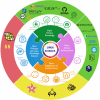A Decade of GigaScience: Milestones in Open Science
- PMID: 35818690
- PMCID: PMC9273954
- DOI: 10.1093/gigascience/giac067
A Decade of GigaScience: Milestones in Open Science
Abstract
Open Science has gained momentum over the past decade, and embracing that, GigaScience, from its launch a decade ago has aimed at pushing scientific publishing beyond just making articles open access toward making the entire research process open and available as an embedded part of the publishing process. Before the journal's launch in July 2012, the editors aimed to make publishing more than a narrative presentation of work already done into a fully open process. Major milestones include creating our own data repository, embracing FAIR principles, promoting and integrating preprints, and working with other platforms to contribute to a 21st century publishing infrastructure. Almost 10 years after GigaScience's launch, UNESCO published its Open Science Recommendations. With these in mind, looking back, we are happy to have contributed in various ways to UNESCO's aim to "foster a culture of Open Science and aligning incentives for Open Science" from the very beginning, and, more, to use those recommendations to guide our path into the future: to truly embrace the full spectrum of information, tools, and access to Open Science for all participants in scientific endeavours.
© The Author(s) 2022. Published by Oxford University Press GigaScience.
Conflict of interest statement
All of the authors work for GigaScience Press.
Figures

Similar articles
-
GigaDB: announcing the GigaScience database.Gigascience. 2012 Jul 12;1(1):11. doi: 10.1186/2047-217X-1-11. Gigascience. 2012. PMID: 23587345 Free PMC article.
-
GigaByte: Publishing at the Speed of Research.GigaByte. 2020 Jul 1;2020:gigabyte1. doi: 10.46471/gigabyte.1. eCollection 2020. GigaByte. 2020. PMID: 36824595 Free PMC article.
-
[The different models of scientific journals].Med Trop Sante Int. 2023 Dec 8;3(4):mtsi.v3i4.2023.454. doi: 10.48327/mtsi.v3i4.2023.454. eCollection 2023 Dec 31. Med Trop Sante Int. 2023. PMID: 38390021 Free PMC article. French.
-
WASP: Is open access publishing the way forward? A review of the different ways in which research papers can be published.Early Hum Dev. 2018 Jun;121:54-57. doi: 10.1016/j.earlhumdev.2018.02.017. Epub 2018 Feb 28. Early Hum Dev. 2018. PMID: 29499986 Review.
-
Ten years of AoB PLANTS the open access journal for plant scientists: inception and progress since 2009.AoB Plants. 2019 May 10;11(3):plz025. doi: 10.1093/aobpla/plz025. eCollection 2019 Jun. AoB Plants. 2019. PMID: 31114670 Free PMC article. Review.
References
-
- Fister B. An Academic Spring? [UPDATED]. Am Libr. 2012. https://americanlibrariesmagazine.org/2012/04/04/an-academic-spring-upda....
Publication types
LinkOut - more resources
Full Text Sources
Miscellaneous

